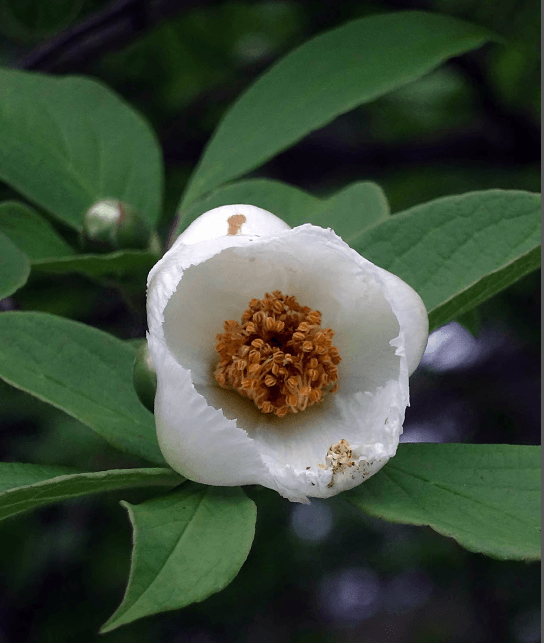

A light rain is falling, cooling off the sultry heat of early summer in Kyoto. As I walk up the stone pathway to Torin-in, I can just make out the fragile blossoms of the sarasôju tree on the other side of the wall. Before going inside the temple, I remove my shoes and fold up the paper umbrella, leaving it in the stand in the entryway next to the others.
folding up
my paper umbrella
closed petals
I walk across the tatami mat room and sit in a far corner, away from the flock of Japanese women who are exclaiming “Kirei, ne!” Beautiful!. We have all come here to enjoy the transient beauty of the sarasôju, some of us more vocally than others.
sarasôju blossoms
in the morning
shining with dew
in the evening
moldering
The sound of rain is refreshing, but it is weighing down the delicate flowers.
moment by moment
rain loosens their hold
on the mother tree
They fall softly on the moss, one by one. I watch them, lost in reverie. Suddenly I am startled by a deep croaking sound—and then another. At the same time, my eyes fill with the blue of hydrangeas.
beyond the temple wall
a bullfrog croaks
blue, blue ajisai
Then the brown-eared bulbuls join in with their raucous chorus. In ancient Japanese poetry, they are called hiyodori, a much more romantic name. Their heavy gray bodies shake the branches of the sarasôju tree.
noisy bulbuls
suck nectar from flowers
that live only one day
Flapping their wings and fighting for the exotic nectar,
the irreverent birds
knock down the flowers
before their time
trying to guess
which flower
will drop off next
The falling blossoms carry my eyes downward to the display on the moss. Their arrangement looks suspiciously like the photograph on the pamphlet taken last year. I imagine the head priest or gardener rearranging the blossoms every morning before the temple opens.
spaced so evenly
did they really fall randomly
from the branches
In the grayness of the afternoon, the white of the sarasôju is so bright and the moss luxuriantly green. My eyes stray to the wall with its restful patina of age; it reminds me of my favorite wall at Ryoan-ji Temple.
rain-soaked moss
on the temple wall
a blush of rust
From the wall composed of many rocks, I focus on a single rock in the garden, which is unusual because of its elegant boat-like shape.
sarasôju fall
hollows in the rock
fill with rain
Each blossom has fallen at a different time today. Those fallen early this morning are already brown, others are browning at the edges and the most recent ones still look fresh.
in different stages
of decay, yet
each one perfect
The temple priest rings the bell to indicate that it’s closing time. Looking around, I am surprised to discover that I am the only one there, completely absorbed in this garden of impermanence.
closing time
but waiting for my blossom
to
fall
Note: When the Buddha died, there were two sarasoju (sal) trees growing at each of the cardinal points surrounding his bier. A cutting from one of these was brought to Kyoto and planted in a small garden at Torin-in Temple where it blooms every year in early July.
Previously published in Hermitage Journal (Romania) c. 1999; republished with permission.

Margaret Chula lived in Japan for twelve years where she taught English and creative writing at universities in Kyoto. Her books include Grinding my ink (Haiku Society of America Book Award); This Moment; Shadow Lines (with Rich Youmans); Always Filling, Always Full; and The Smell of Rust.
Margaret lives in Portland, Oregon, where she continues to teach and give work- shops at universities, poetry societies and Zen centers.